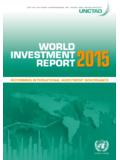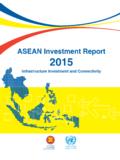Transcription of World Interpretation in a Changing Time - Treaty …
1 Please cite this paper as:Gordon, K. and J. Pohl (2015), investment treaties overTime - Treaty Practice and Interpretation in a ChangingWorld , OECD Working Papers on International investment ,2015/02, OECD Working Papers on InternationalInvestment 2015/02 investment treaties overTime - Treaty Practice andInterpretation in a ChangingWorldKathryn Gordon, Joachim PohlJEL Classification: F21, F53, K33, N40, P45 OECD WORKING PAPERS ON INTERNATIONAL investment The international investment working paper series including policies and trends and the broader implications of multinational enterprise is designed to make available to a wide readership selected studies by the OECD investment Committee, OECD investment Division staff, or by outside consultants working on OECD investment Committee projects. The papers are generally available only in their original language English or French with a summary in the other if available.
2 Comment on the series is welcome, and should be sent to or the investment Division, OECD, 2, rue Andr Pascal, 75775 PARIS CEDEX 16, France OECD WORKING PAPERS ON INTERNATIONAL investment are published on OECD Working Papers should not be reported as representing the official views of the OECD or of its member countries. The opinions expressed and arguments employed are those of the authors. Working Papers describe preliminary results or research in progress by the author(s) and are published to stimulate discussion on a broad range of issues on which the OECD works. Comments on Working Papers are welcomed, and may be sent to or the investment Division, Directorate for Financial and Enterprise Affairs, OECD, 2 rue Andr -Pascal, 75775 Paris Cedex 16, France. This document and any map included herein are without prejudice to the status of or sovereignty over any territory, to the delimitation of international frontiers and boundaries and to the name of any territory, city or area.
3 OECD 2015 Applications for permission to reproduce or translate all or part of this material should be made to: OECD Publishing, or by fax 33 1 45 24 99 30. 3 investment treaties over time - Treaty practice and Interpretation in a Changing World by Kathryn Gordon and Joachim Pohl ABSTRACT investment Treaty law reflects a permanent tension between stability and flexibility. Stability nurtures predictability, while flexibility helps legal systems stay in alignment with Changing circumstances and evolving needs. This paper establishes an inventory of the mechanisms in investment Treaty law that provide flexibility and surveys relevant Treaty practice. The paper: analyses the drivers of change in investment Treaty law; provides an inventory of countries options and limits to alter their positioning vis- -vis investment Treaty law through exit and voice ; and analyses Treaty provisions on, and States use of, flexibility in investment Treaty law.
4 The paper finds that most treaties provide for little or no mechanism for countries to influence the use and Interpretation of investment Treaty law. The paper further finds that Treaty provisions for exit are likewise geared to provide stability rather than flexibility. Analysis of State practice presented in the paper shows that States rarely make use of the mechanisms available to them to influence Treaty use and Interpretation and that exit from the system has likewise been rare so far. Approved by Pierre Poret, Deputy Director, OECD Directorate for Financial and Enterprise Affairs JEL Classification: F21; F53; K33; N40; P45 Keywords: investment treaties , international investment agreements, investment protection, international investment law. 4 Table of Contents Executive 5 Introduction .. 6 1. Drivers of countries re-evaluation of investment Treaty law.
5 9 Structural change in the global economy changes countries perspectives .. 9 Updating legal and economic analyses of Treaty implications after ratification .. 9 Direct experience responding to investor claims .. 10 Learning from experiences responding to Treaty -based claims .. 10 2. The roles of States and tribunals in investment Treaty Interpretation .. 12 3. Exit and Voice Strategies for adapting investment law to Changing circumstances .. 16 4. Exit Treaty provisions and state practice on IIA 18 Lock in effects estimating their size and prevalence .. 20 5. Options for voice how governments can influence their positioning in the international investment law system .. 23 a. Means that States may use to influence the Interpretation of international investment agreements .. 23 (1) Careful Treaty drafting .. 24 (2) Joint or unilateral instruments clarifying meaning and Treaty parties intent.
6 25 (3) Pleadings filed by respondent governments for ISDS cases .. 25 (4) Submissions by non-disputing parties to an investment 26 b. Built-in Treaty mechanisms that permit States to influence Treaty Interpretation .. 26 (1) Ad hoc interpretations and authoritative interpretations by Treaty institutions .. 26 (2) Joint determinations on the nature of tax or prudential measures .. 29 (3) Other consultation mechanisms that allow states to influence Treaty interpretations .. 31 c. Treaty amendments and replacements .. 32 (1) Treaty amendments .. 33 (2) investment Treaty replacements renegotiations resulting in new treaties .. 35 6. Conclusions .. 40 Figures Figure 1. Projection of duration of continued validity of treaties after termination .. 21 Figure 2. Projection of future validity of treaties concluded by selected countries.
7 22 Figure 3. The dynamics of investment Treaty formation and replacement .. 36 5 Executive Summary investment Treaty law, like all systems of law, reflects a permanent tension between stability and flexibility. Stability nurtures predictability, while flexibility helps legal systems stay in alignment with Changing circumstances and evolving needs. This paper establishes an inventory of the mechanisms in investment Treaty law that provide flexibility and provides supporting surveys of relevant Treaty practice. The paper begins with a brief overview of the drivers of change in investment Treaty law ( Changing structural conditions in the global economy, growing country experiences as respondents, and Treaty partners learning from this experience). However, the paper emphasises at the outset that so far, many countries are confident of the benefits of the current state of investment Treaty law in general and of their Treaty practice in particular.
8 The paper then provides an inventory of the options available to countries seeking to alter their positioning vis- -vis investment Treaty law. These options are organised into two broad categories. The first option is exit , the most drastic approach to change, in which countries seek to leave the Treaty system entirely. To date, exit from investment Treaty obligations has been rare, with nineteen treaties known to have been terminated unilaterally, and two treaties terminated consensually. The results of a survey of Treaty provisions relating to exit are provided using the OECD s database of 2,061 treaties to which FOI participants are party. A simulation is run using a scenario of immediate and unilateral termination all of the treaties in the sample as soon as such termination is permitted under the Treaty .
9 The simulation uses as inputs the 2,061 treaties provisions on validity periods (these prohibit unilateral termination by Treaty partners for a fixed period of time) and survival clauses (which extend certain Treaty protections for specified usually already made investments). Taking 2014 as the starting year for the simulation, the results show that, although two thirds of treaties in the sample could be unilaterally terminated within a year s time, 90 per cent of the treaties in the sample would continue to have some binding effect until at least 2025. Thus, investment treaties appear, on average, to provide for significant stability in Treaty -based protections for covered investors via their validity and survival clauses. The second option for influencing countries positioning vis- -vis investment Treaty law is voice.
10 Voice in this context means that Treaty partners use unilateral or multilateral tools to influence the use and Interpretation of investment Treaty law. The paper examines Treaty parties options for voice and maps relevant Treaty practice. Options for voice include: crafting of clear Treaty language during negotiations, filings by non-disputing parties for ISDS cases, other evidence of state practice such as model treaties , authoritative interpretations and other statements clarifying the meaning of Treaty provisions, Treaty amendments and protocols and Treaty replacement through renegotiation. The survey of Treaty practice shows that by far the most common approach is silence on partners options for influencing Treaty Interpretation . A few countries provide for filings by non-respondent Treaty partners and authoritative interpretations, but these are extremely rare and concentrated almost exclusively among countries located in the Americas.













